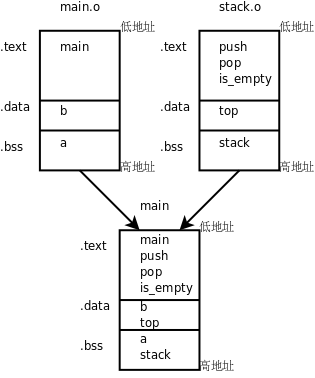现在我们把例 12.1 “用堆栈实现倒序打印”拆成两个程序文件,stack.c实现堆栈,而main.c使用堆栈:
/* stack.c */
char stack[512];
int top = -1;
void push(char c)
{
stack[++top] = c;
}
char pop(void)
{
return stack[top--];
}
int is_empty(void)
{
return top == -1;
}这段程序和原来有点不同,在例 12.1 “用堆栈实现倒序打印”中top总是指向栈顶元素的下一个元素,而在这段程序中top总是指向栈顶元素,所以要初始化成-1才表示空堆栈,这两种堆栈使用习惯都很常见。
/* main.c */
#include <stdio.h>
int a, b = 1;
int main(void)
{
push('a');
push('b');
push('c');
while(!is_empty())
putchar(pop());
putchar('\n');
return 0;
}a和b这两个变量没有用,只是为了顺便说明链接过程才加上的。编译的步骤和以前一样,可以一步编译:
$ gcc main.c stack.c -o main
也分可以多步编译:
$ gcc -c main.c $ gcc -c stack.c $ gcc main.o stack.o -o main
如果按照第 2 节 “main函数和启动例程”的做法,用nm命令查看目标文件的符号表,会发现main.o中有未定义的符号push、pop、is_empty、putchar,前三个符号在stack.o中实现了,链接生成可执行文件main时可以做符号解析,而putchar是libc的库函数,在可执行文件main中仍然是未定义的,要在程序运行时做动态链接。
我们通过readelf -a main命令可以看到,main的.bss段合并了main.o和stack.o的.bss段,其中包含了变量a和stack,main的.data段也合并了main.o和stack.o的.data段,其中包含了变量b和top,main的.text段合并了main.o和stack.o的.text段,包含了各函数的定义。如下图所示。
为什么在可执行文件main的每个段中来自main.o的变量或函数都在前面,而来自stack.o的变量或函数都在后面呢?我们可以试试把gcc命令中的两个目标文件反过来写:
$ gcc stack.o main.o -o main
结果正如我们所预料的,可执行文件main的每个段中来自main.o的变量或函数都排到后面了。实际上链接的过程是由一个链接脚本(Linker Script)控制的,链接脚本决定了给每个段分配什么地址,如何对齐,哪个段在前,哪个段在后,哪些段合并到同一个Segment,另外链接脚本还要插入一些符号到最终生成的文件中,例如__bss_start、_edata、_end等。如果用ld做链接时没有用-T选项指定链接脚本,则使用ld的默认链接脚本,默认链接脚本可以用ld --verbose命令查看(由于比较长,只列出一些片断):
$ ld --verbose
...
using internal linker script:
==================================================
/* Script for -z combreloc: combine and sort reloc sections */
OUTPUT_FORMAT("elf32-i386", "elf32-i386",
"elf32-i386")
OUTPUT_ARCH(i386)
ENTRY(_start)
...
SECTIONS
{
/* Read-only sections, merged into text segment: */
PROVIDE (__executable_start = 0x08048000); . = 0x08048000 + SIZEOF_HEADERS;
.interp : { *(.interp) }
.note.gnu.build-id : { *(.note.gnu.build-id) }
.hash : { *(.hash) }
.gnu.hash : { *(.gnu.hash) }
.dynsym : { *(.dynsym) }
.dynstr : { *(.dynstr) }
.gnu.version : { *(.gnu.version) }
.gnu.version_d : { *(.gnu.version_d) }
.gnu.version_r : { *(.gnu.version_r) }
.rel.dyn :
...
.rel.plt : { *(.rel.plt) }
...
.init :
...
.plt : { *(.plt) }
.text :
...
.fini :
...
.rodata : { *(.rodata .rodata.* .gnu.linkonce.r.*) }
...
.eh_frame : ONLY_IF_RO { KEEP (*(.eh_frame)) }
...
/* Adjust the address for the data segment. We want to adjust up to
the same address within the page on the next page up. */
. = ALIGN (CONSTANT (MAXPAGESIZE)) - ((CONSTANT (MAXPAGESIZE) - .) & (CONSTANT (MAXPAGESIZE) - 1)); . = DATA_SEGMENT_ALIGN (CONSTANT (MAXPAGESIZE), CONSTANT (COMMONPAGESIZE));
...
.ctors :
...
.dtors :
...
.jcr : { KEEP (*(.jcr)) }
...
.dynamic : { *(.dynamic) }
.got : { *(.got) }
...
.got.plt : { *(.got.plt) }
.data :
...
_edata = .; PROVIDE (edata = .);
__bss_start = .;
.bss :
...
_end = .; PROVIDE (end = .);
. = DATA_SEGMENT_END (.);
/* Stabs debugging sections. */
...
/* DWARF debug sections.
Symbols in the DWARF debugging sections are relative to the beginning
of the section so we begin them at 0. */
...
}
==================================================ENTRY(_start)说明_start是整个程序的入口点,因此_start是入口点并不是规定死的,是可以改用其它函数做入口点的。
PROVIDE (__executable_start = 0x08048000); . = 0x08048000 + SIZEOF_HEADERS;是Text Segment的起始地址,这个Segment包含后面列出的那些段,.plt、.text、.rodata等等。每个段的描述格式都是“段名 : { 组成 }”,例如.plt : { *(.plt) },左边表示最终生成的文件的.plt段,右边表示所有目标文件的.plt段,意思是最终生成的文件的.plt段由各目标文件的.plt段组成。
. = ALIGN (CONSTANT (MAXPAGESIZE)) - ((CONSTANT (MAXPAGESIZE) - .) & (CONSTANT (MAXPAGESIZE) - 1)); . = DATA_SEGMENT_ALIGN (CONSTANT (MAXPAGESIZE), CONSTANT (COMMONPAGESIZE));是Data Segment的起始地址,要做一系列的对齐操作,这个Segment包含后面列出的那些段,.got、.data、.bss等等。
Data Segment的后面还有其它一些Segment,主要是调试信息。关于链接脚本就介绍这么多,本书不做深入讨论。
